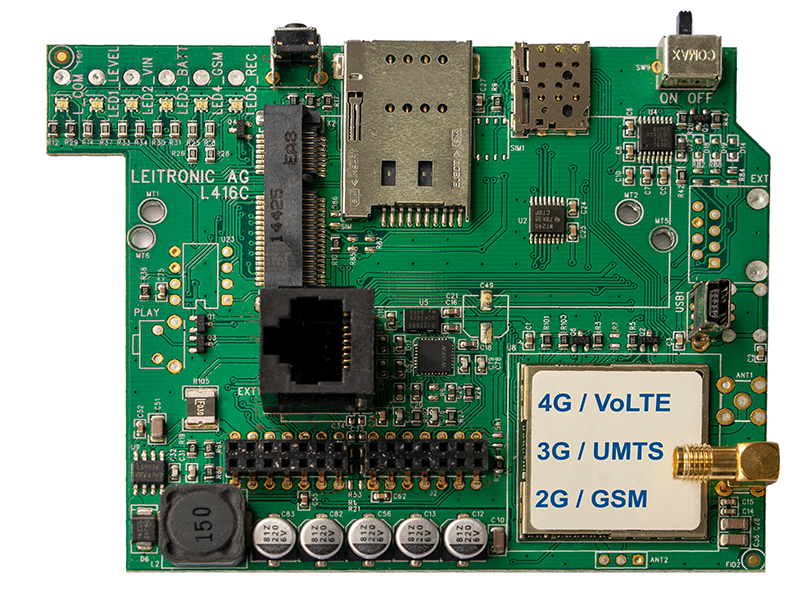Photo: © helinntonfantin/123RF.com

News | April 2024
The Spaniards are coming
Do the Big 4 have to get ready for expansion? A company transaction largely unnoticed by the public now points to this.

(Photo: © Leitronic)
November 2019
From the provider point of view, lifts and emergency call systems are just a "niche". VoLTE is only now gradually becoming standard. The Swiss company Leitronic is already providing easy ways to retrofit.
With the mobile communications technology LTE, which has been available since 2010/2011, fast Internet has also been possible on the move. Voice telephony by contrast is usually still transmitted via 2G or 3G. VoLTE, short for "Voice over LTE", now promises great improvements here – both for providers as well as for consumers. Nevertheless, LTE is currently for the most part used for data transmission.
The mobile communications protocols (2G: GMS/3G UMTS) were still developed for telephony. The network which a device is currently logged into is always used for a call. 4G/5G: LTE by contrast are pure IP (Internet protocol) networks.
Customary services like telephony and SMS have to be replicated. In telephone service, this technology is then called "Voice over LTE" (VoLTE). To ensure this works, all components involved have to cooperate, i.e. the mobile communications device, the SIM card and the provider.
Up to now, you usually needed a smartphone of the respective network operator with software branding. The solution via so-called open market smartphones or industrial devices, VoLTE usually did not work in the case of VoLTE even if they supported LTE telephony in principle.
 In this case, the network was changed for a call. This is called "fallback", i.e. reverting to a 2G or 3G network. The difficult aspect here is that the reception displayed only reveals the quality of the 4G network. You cannot predict how good the reception for making telephone calls in the 2G or 3G network will remain. If these networks are gradually being shut down, devices without VoLTE show good reception, but making telephone calls is not possible.
In this case, the network was changed for a call. This is called "fallback", i.e. reverting to a 2G or 3G network. The difficult aspect here is that the reception displayed only reveals the quality of the 4G network. You cannot predict how good the reception for making telephone calls in the 2G or 3G network will remain. If these networks are gradually being shut down, devices without VoLTE show good reception, but making telephone calls is not possible.
The manufacturers of industrial devices are also lagging behind in terms of VoLTE. The modules installed in the devices are usually not intended for making telephone calls, but instead just for pure data transmission. As early as 2015, Leitronic presented its first 4G gateway prototype. The supplier has in the meantime achieved hard- and software market readiness so that it can now begin to deliver VoLTE-capable lift alarm equipment.
The planned or already carried out phased 2G shutdowns in Switzerland and the Netherlands or of 3G in other European countries are now putting providers and industry under pressure to offer VoLTE for all SIM cards. At the interlift, Leitronic demonstrated that this now works on the device side.
For Swiss customers in particular, it is important that the devices support 4G/VoLTE and 3G. In the EU by contrast, the combination of 4G/VoLTE and 2G appears to be establishing itself.
Leitronic reacted to the decision of all providers immediately and equipped all 4G VoLTE modules for the best possible redundancy with 3G and 2G fallback modules.
The general rule is: Leitronic system solutions are modular in design. The priority here is reusing what is tried-and-tested, i.e. the greatest possible simplification of installation, updating and maintenance. This eliminates the need for expensive installation work to update existing units.
New mobile communications standards, such as 4G/VoLTE or in the event of it becoming ready for the market, of 5G as well, can be retrofitted simply by exchanging a pcb board. Consequently, replacing the complete emergency call device is unnecessary.
Forward-looking technology, straightforward and low-cost conversion options as well as cloud-based administration and support - according to the Swiss manufacturer Leitronic, it bundles all new and innovative know-how under one roof.
Write a comment